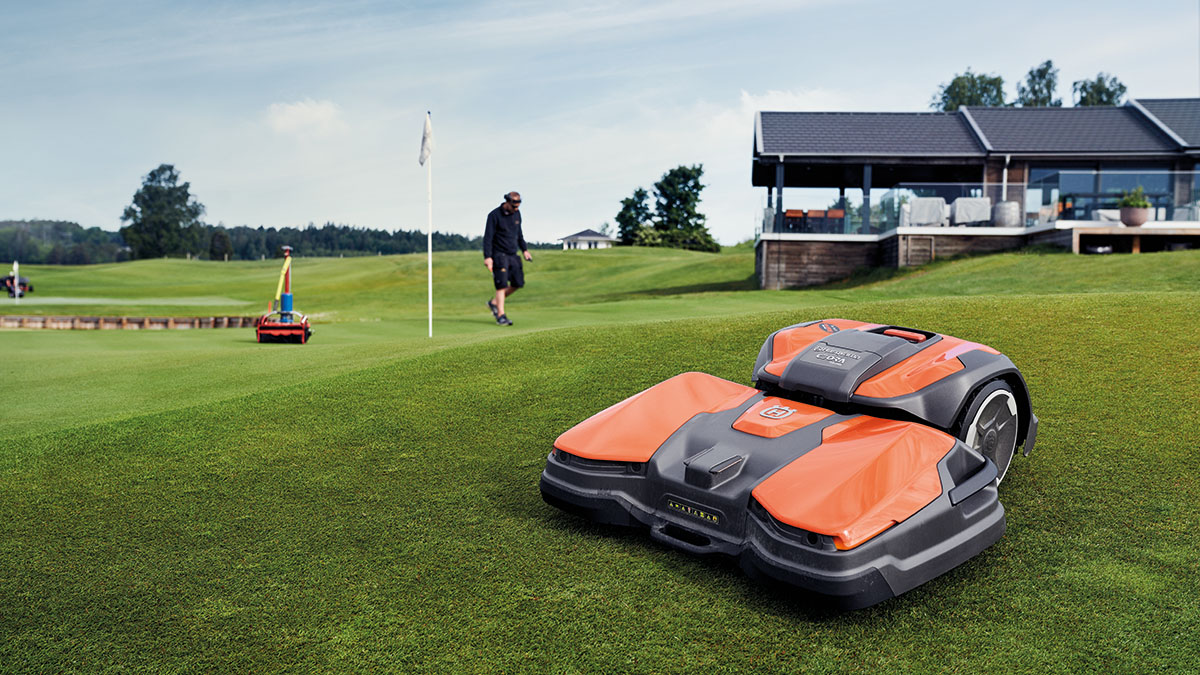- Homepage
- News and Features
- Cutting the grass so you don't have to - is the era of robots here?
Cutting the grass so you don't have to - is the era of robots here?
With autonomous machinery becoming more commonplace on golf courses, Greenkeeper International spoke to Husqvarna's Yvette Henshall-Bell to learn how the sport is steadily embracing the possibilities presented by automation.

‘All you do is cut grass’ – most greenkeepers will have heard that phrase at some point, probably more than once. For those in the know, it’s practically a running joke, but for many others it’s a genuine misconception about a profession that is commonly misunderstood and hugely underestimated. But just imagine what those people will say when they find out that cutting grass may soon be a thing of the past for greenkeepers.
Autonomous mowing solutions are not new, having been introduced to the market by Husqvarna as far back as 1995, when small, domestic-use products hinted at the potential of the technology. Things have moved on quite a bit in the nearly three decades since, with the advent of more efficient and in some cases much larger products designed specifically with sports turf and golf course maintenance in mind.

'Autonomous mowers will effectively become an extra member of the team'
Yvette Henshall-Bell
Husqvarna Forest and Garden Division
To meet the requirements of golf facilities, the need for the kind of physical boundary wires associated with those early devices has been negated by satellite location systems, ensuring there are no obstacles to aerating, scarifying and general turf repair.
That same level of precision and reliability extends to the ability of the machines to fulfill their core duty, with electric cutting height adjustment systems allowing them to tend to everything from the rough to the fairways, cutting from 60 milimetres down to 10.
With machines out on the course doing the mowing, that frees up time for greenkeepers to see to the many other tasks they have, because as we all know, the job is so much more than just cutting the grass.
An opportunity, not a threat
There are professions in which automation is seen as a threat, with the potential for machines to do the jobs that were once the exclusive reserve of humans – and without the desire to ever have a day off sick, go on holiday, or hand in their notice. But according to Yvette Henshall-Bell, president – European Business Unit at Husqvarna Forest and Garden Division, golf is steadily embracing the possibilities presented by automation.
“People see it as an opportunity and they’re eager to understand more about what this technology can do for them,” she said at BTME, where Husqvarna was showcasing its range of automated mowers. “Because of that, we’ve invested quite heavily and doubled our customer-facing team in the UK. We have technical specialists – people knowledgeable about the products, what they can do, and how they can benefit facilities – on hand specifically for people within golf and the wider sports turf industry. What we help them to understand is that these autonomous mowers will effectively become an extra member of the team.”
With many clubs facing the dual pressures of labour shortages and the ever-present demand for high-quality playing conditions, the option to bolster their workforce with technology-based solutions will be appealing. It also needn’t be the case that anyone is forced to choose between one solution or the other – automated or manual – as many clubs operate a combination of the two.
“Nobody is immediately going and replacing all their traditional grass-cutting machines with autonomous ones, and we wouldn’t expect that,” said Henshall-Bell. “They will maybe try one or two, use them on a couple of holes, and then from there they look at expanding that and adding to their fleet to take on more of the golf course.”
A boon for sustainability
The topic of sustainability now dominates the conversation regarding the future of golf course maintenance, and it’s another area where automation may again provide at least part of the answer.

'A lot of golf courses have neighbours around them who don’t want to be woken up at six o’clock in the morning by the noise of a petrol lawnmower'
Pär Forsman
Husqvarna UK
Pär Forsman, product manager for robotic lawnmowers at Husqvarna, explained how his company’s products – built in a net carbon-neutral factory in Durham’s Newton Aycliffe – and others like it can also demonstrate their value on that front.
“Lifecycle analysis compared an autonomous mower with one of our own ride-on mowers and showed an 83% lower climate impact – covering production on the unit, usage, and scrapping at the end," he. said. “You can reduce that even further if the electricity used to power the mowers comes from renewable sources.”
And Forsman pointed out that autonomous mowers are a quieter alternative, reducing noise pollution too.
“A lot of golf courses have neighbours around them who don’t want to be woken up at six o’clock in the morning by the noise of a petrol lawnmower, and these automated mowers are much quieter, which is also less disruption for the players.”
What about the bottom line?
Beyond environmental pressures and those brought about by the demands and expectations of players, golf clubs must also weigh up the financial impact of any decision to change how they operate.
When it comes to the return on investment on these products, Henshall-Bell cited several factors that will feed into that calculation, including the methods currently employed by clubs to cut the grass, the cost of labour, and the frequency of cutting, but she pointed to some compelling figures.
As labour can account for up to 70% of the total cost of turf maintenance, swapping out ride-on and walk-behind mowers for an automated machine does present a financial benefit over a certain timeframe, taking into account the initial outlay.
“That’s probably one of the first things we have to do with customers – sit with them and show the cost benefit to owning one of these products,” explained Henshall-Bell. “We can demonstrate a 30% saving on their cost over five years compared to someone sitting on a traditional grass-cutting machine, and we’ve seen examples of golf courses saving significantly more than that, up to 50%.”
In many cases, the products are not sold but leased to facilities, who are then charged monthly.
The future of autonomous mowing
Although autonomous mowing products are already in operation at many golf courses in the UK, the room for growth is evident and Henshall-Bell is confident adoption rates will increase as those who already utilise the technology espouse its benefits.
“Greenkeeping as an industry is quite good at sharing best practice,” she said. “I think we’ll see adoption continue to grow as we see the impact of that knowledge sharing.”
When asked what they would like to see from autonomous mowing products of the future, there are some recurring themes among greenkeepers – when, for example, will they be able to cut greens? And what about raking bunkers, blowing leaves, and removing dew? All in good time, Henshall-Bell believes.
“Golf facilities want to provide great playing arenas and we can help them do that in the most sustainable and cost-efficient way. Once you spark the interest of what autonomous solutions can provide, you’re only limited by your own imagination. There’s so much potential.”
Author



